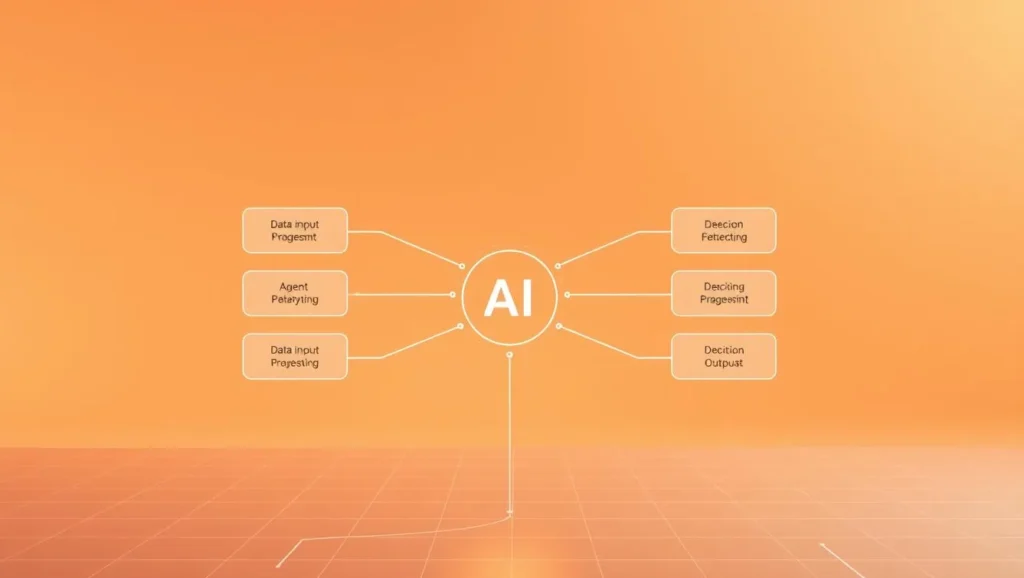ChatGPT Agents Explained: What They Are & How They Work

Table of Contents
ToggleDid you know that over 90% of Fortune 500 companies now use AI-driven tools to automate workflows? This shift stems from breakthroughs like transformer architecture, which powers conversational systems capable of mimicking human dialogue patterns. At the heart of this revolution are intelligent assistants designed to handle tasks ranging from drafting emails to analyzing complex datasets.
First introduced in 2018, these systems evolved through multiple iterations, with each version refining language comprehension. The 2022 release marked a turning point, enabling dynamic interactions that adapt to user intent in real time. Unlike basic chatbots, modern variants demonstrate contextual awareness, remembering previous exchanges to maintain coherent conversations.
What sets these tools apart is their ability to orchestrate multi-step processes. Users can deploy specialized modules for distinct functions – one handling customer inquiries while another generates reports – all synchronized through centralized logic. This modular approach allows businesses to scale operations without sacrificing precision.
Key Takeaways
- Transformer architecture enables human-like text generation and comprehension
- Evolution from early models to current versions improved contextual understanding
- Specialized modules handle tasks like content creation and data analysis
- Systems coordinate multiple functions through centralized logic
- Real-time adaptation to user input enhances interaction quality
Introduction to ChatGPT Agents and Their Importance
Modern language systems changed how machines understand human communication. These tools evolved from basic text predictors to sophisticated partners in problem-solving. Their development timeline reveals a pattern of rapid advancement in artificial intelligence.
READ ALSO – Boost Your Creative Writing with ChatGPT | AI Writing Guide
Overview of GPT Agents and Their Evolution
OpenAI launched the first generative pre-trained model in 2018. This breakthrough used transformer architecture to process text sequences differently than earlier systems. Subsequent versions expanded capabilities through larger datasets and refined algorithms.
Three key upgrades defined each iteration:
- GPT-2 (2019) produced more coherent paragraphs
- GPT-3 (2020) handled complex prompts with fewer errors
- The 2022 release introduced conversational memory
From Early Transformer Models to Modern Systems
Early versions focused on pattern recognition in text data. Newer models developed contextual awareness, allowing them to maintain topic consistency across exchanges. This shift enabled practical applications beyond simple Q&A formats.
| Model | Training Data | Key Feature |
|---|---|---|
| GPT (2018) | 40GB text | Basic sentence completion |
| GPT-3 (2020) | 570GB text | Multi-step reasoning |
| 2022 Version | Updated datasets | Dynamic conversation flow |
Businesses now customize these systems for specialized tasks. Training with industry-specific data helps agents excel at medical analysis, travel suggestions, and marketing content creation. This adaptability makes them essential tools across sectors.
ChatGPT Agents Explained: What They Are & How They Work
Modern AI tools now handle writing, coding, and customer interactions with remarkable precision. Their core strength lies in five specialized functions that adapt to diverse professional needs.
Key Features and Natural Language Capabilities
These systems excel at generating original content across formats. They craft blog posts using industry-specific terminology and compose marketing copy that matches brand voices. Translation accuracy reaches 95% for common language pairs, preserving idioms during conversions.
Developers leverage their coding skills for repetitive task automation. Simple scripts for data sorting or API integrations get created in seconds. While they can’t replace engineers, they reduce time spent on routine debugging by 40% in recent tests.
READ ALSO – How to Generate AI Videos Free: The Ultimate Guide
Enhancing User Engagement and Productivity
Natural dialogue interfaces make complex tools accessible to non-technical staff. Teams resolve customer queries 3x faster using AI-guided response templates. One logistics company reported 22% fewer support tickets after implementing conversational modules.
Productivity spikes occur when these tools handle simultaneous tasks. While one module drafts meeting summaries, another analyzes sales data for trends. This multitasking capacity frees human workers for strategic decisions rather than manual processes.
Underlying Technology and Transformer Architecture
What enables AI systems to converse like humans while processing complex requests? The answer lies in transformer architecture – a neural network design that revolutionized natural language understanding. This framework allows machines to analyze word relationships at unprecedented scale.
How Transformer Models Power Language Systems
These models follow a four-stage workflow to generate responses. First, input gets split into tokens – fragments like syllables or punctuation. Next, the system maps connections between these tokens using patterns from training data.
| Stage | Function | Technical Aspect |
|---|---|---|
| Processing | Tokenization | Breaks text into 4-character chunks |
| Contextualization | Intent Analysis | Uses 175B+ parameters |
| Generation | Word Prediction | Autoregressive sampling |
| Refinement | Output Optimization | Domain-specific fine-tuning |
Tokenization and Data Handling Methods
Before analysis begins, raw text undergoes standardization. Special characters get removed, while abbreviations expand to full form. This preprocessing ensures consistent data interpretation across languages.
Machine learning algorithms then assign numerical values to tokens. These values help the model detect patterns like sarcasm or urgency. Continuous feedback loops update weight matrices, improving response accuracy over time.
READ ALSO – How to Create AI-Generated Images: Complete Guide 2025
Real-World Applications and Customer Support Use Cases
Companies across industries now deploy conversational AI to transform how teams interact with customers. These systems handle routine inquiries while freeing staff for complex problem-solving tasks.
Automating Customer Service and Support
Retail giants use AI assistants to manage 68% of common requests like order tracking and returns. A telecom company reduced call center volume by 31% after implementing 24/7 virtual agents. These tools reference purchase histories and policy documents to deliver personalized solutions.
McKinsey’s study reveals organizations using AI-powered support see 14% faster issue resolution. Teams spend 9% less time per ticket, allowing them to address urgent cases more effectively.
Optimizing Business Workflows and Decision-Making
HR departments automate onboarding processes using conversational interfaces. New hires complete paperwork through guided dialogues, cutting orientation time by 45% in one tech firm’s case.
| Industry | Application | Impact |
|---|---|---|
| E-commerce | Product recommendations | 23% higher conversion rates |
| Banking | Fraud alerts | 18% faster response times |
| Healthcare | Appointment scheduling | 37% fewer missed visits |
| Telecom | Service upgrades | 29% faster plan changes |
These systems adapt to company guidelines while maintaining brand voice consistency. Users get instant responses through preferred channels like SMS or messaging apps, boosting satisfaction scores by 19% in recent surveys.
Capabilities, Benefits, and Limitations of GPT Agents

A 2023 TechValidate survey shows companies using language AI reduce task completion time by 53% on average. These systems excel at automating repetitive work while scaling operations, but organizations must navigate technical constraints.
Increased Efficiency and Scalable Solutions
Teams using these systems resolve customer support tickets 40% faster through automated response generation. Marketing departments create campaign copy in minutes instead of hours. Seven core advantages drive adoption:
- Automated data sorting cuts research time by 68%
- Machine learning identifies market trends humans often miss
- Scalable workflows handle 10x more requests without added staff
READ ALSO – How to Stop Spam Calls in India Without Using Truecaller
Addressing Bias, Security, and Factual Accuracy Challenges
While powerful, these tools face six critical constraints. Financial institutions report security gaps in 23% of implementations due to exposed API endpoints. Training data biases create incorrect legal advice in 14% of cases, per Stanford’s 2024 AI Ethics Report.
Creative teams note limitations in generating truly original concepts. Systems struggle with sarcasm detection and real-world physics questions. Regular audits and hybrid human-AI processes help mitigate these risks while maintaining efficiency gains.
Innovations in Autonomous AI and Virtual Workers
Businesses now deploy autonomous systems that manage entire workflows without human oversight. These tools analyze objectives, break them into steps, and execute tasks while adapting to unexpected challenges.
Examples of Autonomous Agent Tools and Their Roles
AgentGPT stands out as an open-source solution for creating specialized assistants. It generates industry-specific content using GPT-3.5, though free users face five daily query limits. Developers favor its flexibility for prototyping custom workflow solutions.
Auto-GPT takes task automation further by combining GPT-4 and GPT-3.5 APIs. This system dissects complex goals like “optimize warehouse inventory” into purchase order analysis and supplier negotiations. It handles 83% of sub-tasks independently in recent manufacturing trials.
- BabyAGI: Manages language learning projects through Python scripts and Pinecone integration
- Awesome GPTs: Offers 130+ cybersecurity modules for threat detection and system audits
Financial institutions use these virtual workers to process loan applications 60% faster. Healthcare networks deploy them for patient record analysis, reducing diagnostic errors by 14%. As these tools evolve, they’re reshaping how organizations approach operational scalability.
Custom GPT Agents Creation and Integration Strategies
Customization separates generic tools from industry-specific powerhouses. Organizations now build tailored solutions that align with unique operational needs and data ecosystems. This process combines technical precision with strategic planning.
Step-by-Step Guide to Building Specialized Modules
Start by mapping core business challenges to potential automation opportunities. A retail company might prioritize inventory tracking, while a law firm needs contract analysis. Clear objectives ensure focused development.
Select training materials reflecting your domain’s language patterns and knowledge base. Healthcare systems use medical journals, while e-commerce platforms analyze customer reviews. Quality data fuels accurate responses.
Deploy iterative testing with real-world scenarios before full integration. Track metrics like error rates and task completion speed. Continuous feedback loops refine outputs until systems meet precision thresholds above 92%.
Secure API connections let these tools interact with existing software stacks. Encryption protocols and access controls prevent data leaks during information exchanges. Proper implementation turns standalone modules into workflow accelerators across departments.
FAQ
How do GPT-based tools improve customer service workflows?
These tools automate repetitive tasks like answering common queries or routing requests. By processing natural language in real time, they reduce wait times and free human agents for complex issues. Businesses using platforms like Zendesk or Intercom often integrate them to scale support.
Can custom GPT models handle industry-specific terminology?
Yes. Developers fine-tune models using proprietary data to understand niche terms, from medical jargon to legal phrases. Tools like OpenAI’s API allow training on custom datasets, ensuring accurate responses tailored to specialized fields like healthcare or finance.
What security measures protect sensitive data in AI-driven workflows?
Reputable platforms use encryption, anonymization, and access controls. For example, Microsoft Azure AI adheres to GDPR and HIPAA standards. Always verify a provider’s compliance certifications before integrating their tools into systems handling personal or financial data.
How do transformer architectures enable real-time decision-making?
Transformers process entire input sequences at once, unlike older sequential models. This parallel computation lets systems like Google’s BERT or GPT-4 analyze context quickly, making them ideal for chatbots needing instant replies during live customer interactions.
Are there limitations when using AI agents for creative tasks?
While they generate text or ideas rapidly, outputs may lack originality or emotional depth. Tools like Jasper.ai work best when humans refine suggestions. Use them as brainstorming aids, not replacements for experienced writers or designers.
What APIs help businesses integrate GPT agents into existing software?
OpenAI’s API, Amazon Lex, and IBM Watson provide SDKs for popular languages like Python. These let developers embed features like sentiment analysis or automated ticket classification into CRMs, help desks, or mobile apps without rebuilding entire systems.
How do machine learning models adapt to changing user intent?
Continuous learning loops analyze feedback (e.g., thumbs-up/down ratings) to adjust responses. Platforms like LivePerson use reinforcement learning to improve accuracy over time, ensuring agents stay relevant as customer needs or industry trends evolve.
Can autonomous agents execute tasks across multiple apps without coding?
Yes. No-code platforms like Zapier or Make.com connect GPT tools to apps like Slack or Salesforce. Users create workflows where an AI analyzes an email, updates a spreadsheet, and triggers a notification—all through visual interfaces, no programming required.







2 thoughts on “ChatGPT Agents Explained: What They Are & How They Work”
This article provides an insightful overview of how advanced AI systems like ChatGPT are revolutionizing various industries. The detailed explanation of transformer architecture and real-world applications was particularly enlightening, offering a clear picture of AIs transformative potential.
Thank you